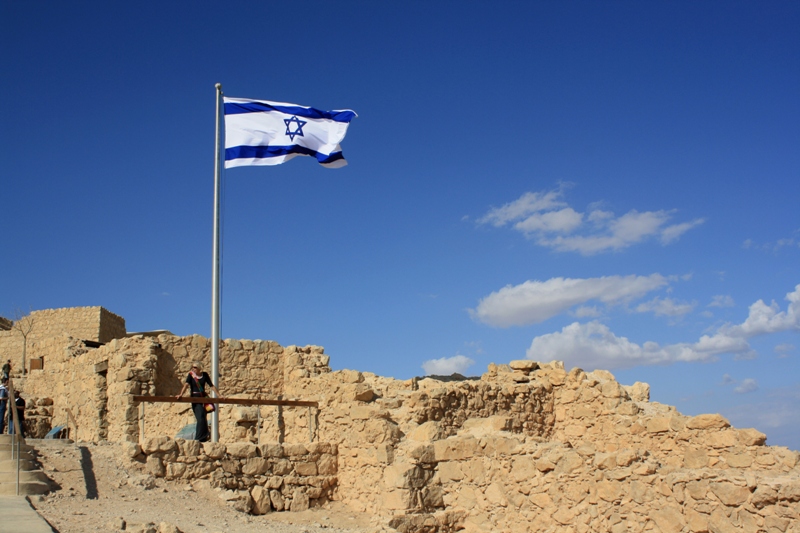Masada, Caesarea: "Sightseeing"
Binyamina
Israel
22 November 2009
Dear Family and Friends,
The town of Binyamina is the final destination of my trip to the Middle East. After five weeks of intense travel in Egypt, Turkey, Rhodes and Turkey again, I am trying to relax with my cousins Miryam and Moshe Lauer.
Miryam is a marvelous cook. Even after a minor surgery on her eyelids yesterday, she is back in the kitchen today preparing all my favorite German-Jewish dishes. So I am relaxing and eating too much. But Moshe! No relaxing with Moshe. Moshe, 81, is an energetic and irrepressible tour guide.
Not far from Binyamina, Ein Hod Artists Village is home to about one hundred thirty five families of sculptors, painters and potters. The rough-hewn stone houses and galleries fill the sunlit winding hilly streets. It seems like every spot has an inspiring view of the Mediterranean. My souvenir of the visit is a small oval red and green ceramic plate with the image of pomegranates on a silver metallic background. The artist is the daughter of a painter and founding member of Ein Hod, Magel Ben-Zion (1908-1999). *
Imagine surviving the camps in Europe, arriving in Palestine, only to be forced into yet another camp! From 1934 to 1948, before the State of Israel was declared, British administrators sent "illegal" Jewish immigrants to detention camps. (Some were deported again to Cyprus.) More than a third of the 120,000 "illegal" immigrants to Palestine were sent to the Atlit detention camp near Haifa. **
Moshe and I visited the rebuilt Atlit camp that includes barracks and grounds surrounded by barbed wire fences, watch towers and military vehicles. The dramatic story, in 1945, of a middle-of-the-night escape, by everyone in the camp, is the subject of a moving film shown in the small auditorium. ***
On my own, I visited Masada in the Dead Sea area of Israel. I took the train to Tel Aviv. Then I waited for a bus that first drove east to Jerusalem and then south, through the Territories and some unusual scenery to the flat top mountain that is famous for the last stand of one thousand Jewish rebels in the Great Revolt against Rome in 73 CE.
After the cable car ride to the top and a visit to the museum with a remarkable display of Jewish secular and religious artifacts, I shuffled across the rocky grounds of this one-time opulent desert escape palace of King Herod. The ruins of the palace, a bathhouse, two mikvahs (Jewish ritual baths) a synagogue and a small 5th Century Byzantine chapel are all well-marked on this UNESCO World Heritage site. The national flag of Israel, the Star of David, proudly hails the magnificent striated mountains, the valleys and plains of every shade of tan and brown, and far below, the frothy shore and deep, deep blue waters of the Dead Sea. It's quite a site! It's quite a sight!
The ancient ruins of the port of Caesarea glisten beside the sparkling sea - there's fishing, sailing, SCUBA diving, and a golden beach. Modern art galleries, souvenir shops and a flotilla of cafés adjoin the Roman walls, archways, towers and hippodrome. While I am wandering around the walls, and taking photos of a Bosnian Mosque, Moshe is making enquiries. Later, we met Vered Cohen, the Caesarea Guide Coordinator to talk history and relate a Lauer family story.
First the history:
After the occupation of Bosnia-Herzegovina by the Austro-Hungarian Empire in 1878, Bosnian Muslims apprehensive of living under Christian rule emigrated to lands administered by the Ottoman Empire. Most emigrants during this time and the period directly after the annexation of Bosnia in 1908 settled in parts of what is now modern Turkey, while a smaller number settled in Syria, Jordan, Lebanon and Palestine.
Bosnian Muslim immigrants settled in Caesarea in 1878 where they built two mosques, joining other Muslim immigrants from Morocco, Algeria, Crimea, the Caucasus and Turkistan. These Slavic speaking immigrants eventually assimilated into the Arab population of Palestine. While some Bosnian Palestinians, like other Palestinians, left during the exodus of 1948, others remained. Their descendants live in villages in what is now northern Israel, their heritage reflected in the Arab surname of Bushnak. ****
The family story:
After the Nuremburg Laws were passed in 1934, Moshe, then a small boy, left Berlin with his brother and his parents. Moshe's father was a doctor. Dr Lauer bought land and became a farmer. But Dr Lauer also opened a small clinic. His patients? The Bosnian Muslims.
Moshe also has photos and the original plaque from the wall of his father's clinic. The plaque reads "Dr. Med. A. Lauer." The second line of the plaque is in Hebrew. The third line is in Arabic script.
Ms Cohen was excited about this little-known piece of history of Northern Israel and she invited Moshe to present a lecture about his father and his family…..
….Sadly, I must leave the Lauer family and return home. As always, they and their children and grandchildren are the most welcoming and generous hosts. I am proud to be a member of their family. I look forward to returning to Israel and seeing them again soon.
Later this year, I also look forward to visiting and meeting for the very first time, many, many, many other members of my extended family. There are about seventy of us. (And that's just on my father's side.) And we live on five continents!
Who are they? Where are they? How did I find them? Well, that's "eine ganz andere Geschichte"…"una historia completamente diferente." That's a whole…other…story.
Always,
Your "Cousin" Jan
* http://ein-hod.info/pgallery/pgallery.htm
** http://en.wikipedia.org/wiki/Atlit_detainee_camp
*** http://www.aish.com/jw/s/50346052.html
**** Cohen, Philip J.; Riesman, David (1996), Serbia's Secret War: Propaganda and the Deceit of History, Texas A&M University Press

